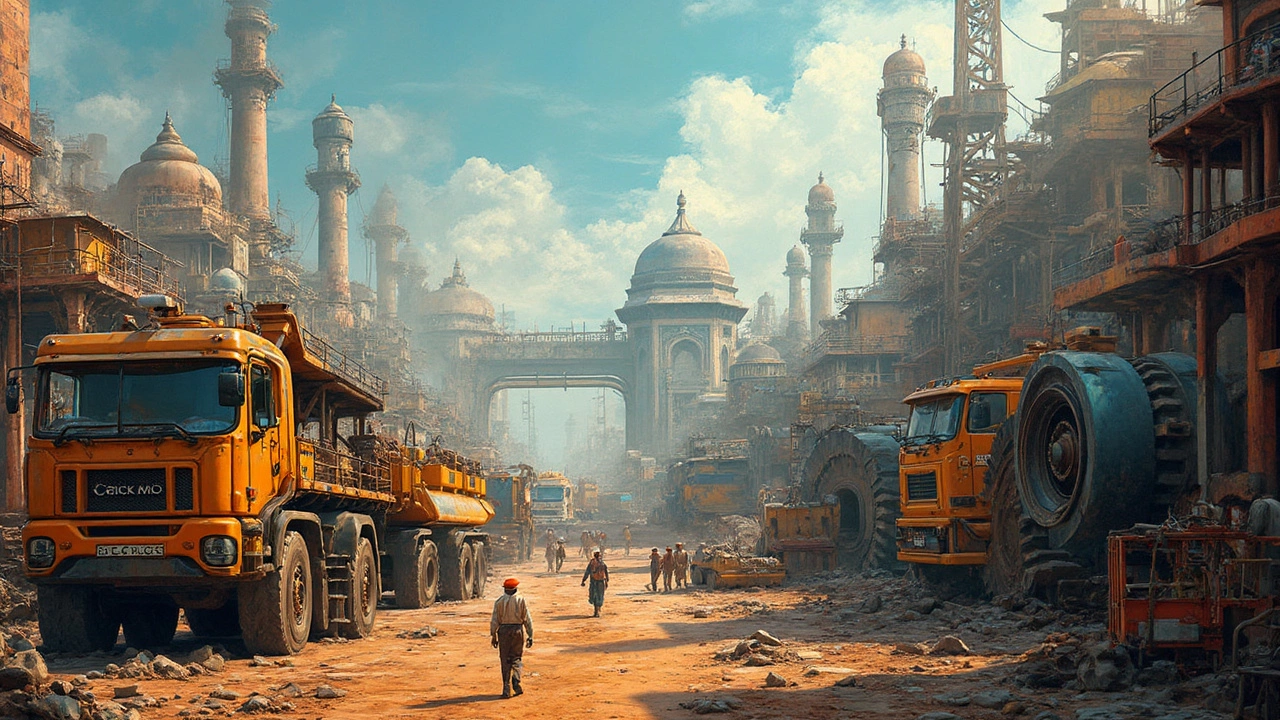When it comes to the best countries in machinery manufacturing, India is making a name for itself on the world stage. Sure, Germany and Japan have long been known for their engineering might, but India’s catching up quickly. What's fascinating is how the Indian machinery industry is blending traditional craftsmanship with cutting-edge technology to churn out some incredible machines.
India's been zooming ahead, especially in heavy machinery production. A mix of competitive pricing, skilled manpower, and a growing tech ecosystem makes India a go-to destination for all things mechanical. For instance, the agriculture machinery sector in India is booming thanks to innovations that are tailored specifically to local needs. Not just agriculture, but sectors like textiles and construction are also seeing mind-blowing advancements, putting India on the map for machinery exports.
- India's Rise in Machinery Manufacturing
- What Sets Indian Machinery Apart
- Key Sectors Leading the Growth
- Technological Advancements in Indian Machinery
- Global Recognition and Future Potential
India's Rise in Machinery Manufacturing
India's journey to becoming a key player in the machinery manufacturers India realm is pretty impressive. Over the past couple of decades, the country has transformed its manufacturing landscape, and machinery is right at the heart of this evolution. It's not just about producing more; it's the way India is doing it that's catching everyone's eye.
Driven by a combination of government support, innovation, and a skilled workforce, India is churning out top-notch machinery. Things really took off with initiatives like the 'Make in India' campaign, launched by the government in 2014. This initiative aimed to encourage companies across the globe to invest and manufacture in India, bringing about an industrial boom.
Moreover, India has become a hub for machinery manufacturers due to its diverse industries such as textiles, agriculture, and automotive, all demanding more advanced machinery. The agriculture sector alone saw a surge in demand for harvesting equipment due to incentives and subsidies offered to local farmers.
Today, India is not just catering to domestic needs but is also a major exporter of machinery. Countries like the U.S., Germany, and China are importing India's machinery, thanks to its competitive quality and pricing. And it's not just small stuff; heavy machinery designed for large-scale industries also rolls out of Indian factories, marking a significant shift in global perception.
There's talk of India potentially outpacing some of the long-standing leaders in the global machinery sector pretty soon. With such growth and innovation happening at a rapid pace, it's no surprise that more global players are looking to partner up or set up shop here. As India continues to expand its capabilities, it's sure to carve out an even bigger niche on the world stage in machinery manufacturing.
What Sets Indian Machinery Apart
So, what's the buzz about India in the machinery world? For starters, the mix of affordability and quality is really making headlines. You might think of machinery manufacturing as something that only happens in ultra-modern factories, but India's been clever by using a combo of tradition and technology that efficiently outputs robust machines.
One of the standout features of machinery manufacturers India is their adaptability. Indian companies are super quick to customize machinery to fit specific local needs or tackle problems that other global giants haven't addressed yet. It's this flexibility that echoes across many sectors, making Indian machinery uniquely suited for diverse environments.
Take the agricultural sector, for example. Indian manufacturers are creating equipment perfect for small and fragmented landholdings, which are common in the country. They aren't just importing solutions; they're crafting specialized machinery that can deal with local soils and crops.
Moreover, the Indian machinery industry is embracing sustainability like never before. With eco-friendly designs and energy-efficient machines, these manufacturers are crazy focused on minimizing environmental impact. Innovations intended to reduce waste and improve energy efficiency are catching the eyes of environmentally conscious buyers globally.
What's really pushing India ahead is also its youthful and tech-savvy workforce. Young engineers and innovators are driving the machinery renaissance by introducing fresh ideas and automation. This tech explosion means Indian manufacturers can produce competitive machinery without jacking up costs.
| Factor | Contribution |
|---|---|
| Customization | Quick adaptation to local needs |
| Eco-friendly Designs | Focus on energy efficiency |
| Cost-Effectiveness | Affordable quality machinery |
So, without a doubt, the Indian machinery industry's edge comes from being both innovative and practical. Not only are they about transacting business—it's about shaping the future of an industry with tailored solutions and sustainable practices.

Key Sectors Leading the Growth
India's machinery manufacturing scene has specific sectors that are really setting the pace. Among them, agriculture machinery stands out as a major player. Given the country's strong agricultural roots, it makes sense that equipment designed for farming would see major demand. Innovations in this sector are massively boosting productivity, with tractors and harvesting equipment evolving each year.
Then there's the construction sector. With India's urbanization at full throttle, construction machinery has seen incredible growth. From advanced cranes to durable earth-moving equipment, India is competing on quality and price. The industry isn't just looking inward; a significant portion of this machinery is exported, showing India's manufacturing quality to the world.
The textile machinery sector is another leader. India is a giant in textile production, so it’s no surprise that this industry is supported by top-notch machinery. Thanks to sophisticated looms and spinning machines, the textile industry runs efficiently, keeping costs low and production high.
But let's not forget about the contribution of the defense and aerospace sectors. More recently, these arenas have seen substantial investments, leading to cutting-edge machinery development. Companies in these fields are not only meeting national demands but also supporting international partners by exporting sophisticated defense equipment.
| Sector | Annual Growth (%) |
|---|---|
| Agriculture Machinery | 12% |
| Construction Machinery | 15% |
| Textile Machinery | 10% |
| Defense and Aerospace | 8% |
These sectors not only highlight India's prowess as a machinery manufacturing hub but also underline the country's capability to innovate and adapt in a fast-changing global market.
Technological Advancements in Indian Machinery
India’s machinery sector isn’t just about numbers; it's about innovation that works in real-life contexts. The country's making waves with its tech-savvy approaches, boosting machinery manufacturers India onto the global platform. One of the coolest things happening is the integration of IoT (Internet of Things) in machines. This tech lets manufacturers gather data in real-time and improve efficiency like never before.
Another big leap is in robotics. Indian factories are increasingly deploying robots for tasks that demand precision and consistency. This is a game-changer in industries like automotive and electronics. Imagine machines coordinating in perfect harmony, reducing manual error, and speeding up production—it’s like a well-oiled machine, literally!
Plus, thanks to India’s robust IT sector, there’s a push towards AI-driven processes. Companies are using AI to predict maintenance needs and product demand, which in return optimizes supply chains and reduces downtime. That’s some next-level planning! Moreover, machine learning is slowly becoming a norm, helping in predictive analytics and quality control which gives Indian manufacturers a competitive edge.
- Adoption of eco-friendly technologies is also noteworthy. Indian machinery companies are developing energy-efficient machines, contributing to sustainable manufacturing practices.
- The use of 3D printing for prototyping and small-batch production is picking up pace, reducing lead times and costs significantly.
According to a recent report, the contribution of tech-savvy machinery to India's economy has risen by 25% just in the last five years. Check out this simple data:
| Year | Economic Contribution (in billion USD) |
|---|---|
| 2020 | 45 |
| 2025 | 56.25 |
This technological leap is not just a talking point; it's the heartbeat of the Indian machinery industry growth story. With these innovations, India isn’t just participating; it’s leading in redefining how machinery manufacturing meets modern-day demands.

Global Recognition and Future Potential
India's standing as a leader in machinery manufacturing is getting some serious spotlight on the global stage. The country’s machinery exports have grown dramatically, with various countries turning to Indian manufacturers for their equipment needs. This isn't just a fluke; it’s a clear sign of India’s growing influence in the industry.
Let's look at the hard numbers. In recent years, machinery exports from India have shot up, contributing significantly to the country's GDP. As of 2024, the machinery sector accounted for a substantial portion of India's export basket, showcasing the country's manufacturing strength. Quite impressive, right?
Why is India gaining traction globally? Well, it’s about a mix of quality and affordability. India manages to offer competitive pricing without compromising on quality, a formula that’s winning over international markets. Products from Indian manufacturers cater to specific needs and are often customizable, which is a huge plus for global buyers.
Now, what does the future hold? India is investing big time in technology and R&D to keep the momentum going. The government’s push for initiatives like ‘Make in India’ plays a huge role here, encouraging local production while attracting foreign investment. The focus is not just on traditional sectors but also on emerging fields like robotics and AI-driven machinery.
- Continued innovation with eco-friendly machinery.
- Expanding presence in European and North American markets.
- Strengthening supply chain logistics to meet international demands.
In sum, India’s not just sitting on its laurels. With the ongoing developments, the country's machinery industry looks all set to keep wowing the world!
